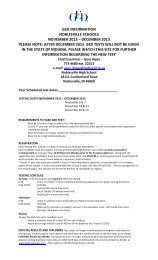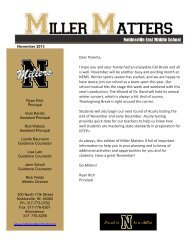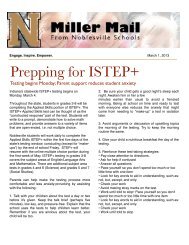Math Curriculum - Noblesville Schools
Math Curriculum - Noblesville Schools
Math Curriculum - Noblesville Schools
You also want an ePaper? Increase the reach of your titles
YUMPU automatically turns print PDFs into web optimized ePapers that Google loves.
SECTION 3.3 – ADD & SUBTRACT FRACTIONS<br />
Chapter Standard<br />
Covered<br />
20 4.2.8<br />
4.NF.3<br />
4.NF.3a<br />
4.NF.3b<br />
4.NF.3c<br />
4.NF.3d<br />
4.NF.4<br />
4.NF.4a<br />
Lesson Topic Days Additional<br />
Activities<br />
20.1 Add & Subtract Fractions with Like<br />
Denominators<br />
2<br />
Understand a fraction a/b where “a” is ><br />
1 as a sum of fractions 1/b.<br />
Understand addition and subtraction of<br />
fractions as joining and separating parts<br />
referring to the same whole.<br />
Decompose a fraction into a sum of<br />
fractions with the same denominator in<br />
more than one way, recording each<br />
decomposition by an equation. Justify<br />
decompositions, e.g., by using a visual<br />
fraction model. Examples: 3/8 = 1/8 +<br />
1/8 + 1/8; 3/8 = 1/8 + 2/8; 2 1/8 = 1 + 1 +<br />
1/8 = 8/8 + 8/8 + 1/8.<br />
Add and subtract mixed numbers with<br />
like denominators, e.g., by replacing<br />
each mixed number with an equivalent<br />
fraction and/or by using properties of<br />
operations and the relationship between<br />
addition and subtraction.<br />
Solve word problems involving addition<br />
and subtraction of fractions referring to<br />
the same whole and having like<br />
denominators, e.g., by using visual<br />
fractions models and equations to<br />
represent the problem.<br />
1<br />
20.6 Add with Unlike Denominators 2<br />
20.7 Subtract with Unlike Denominators 2<br />
Apply and extend previous<br />
understandings of multiplication to<br />
multiply a fraction by a whole number.<br />
1<br />
Understand a fraction a/b as a multiple<br />
of 1/b. For example, use a visual fraction<br />
model to represent 5/4 as the product of 5<br />
x (1/4), recording the conclusion by the<br />
1<br />
Introduce only.<br />
2











